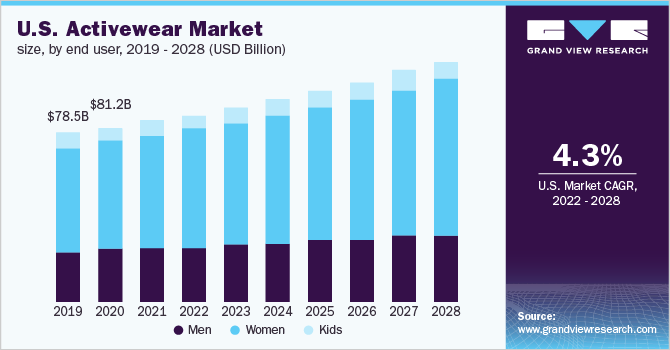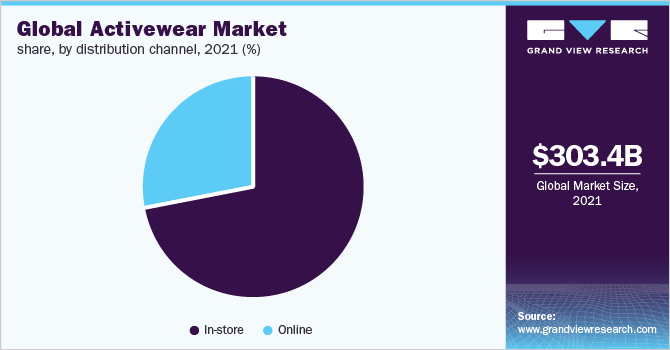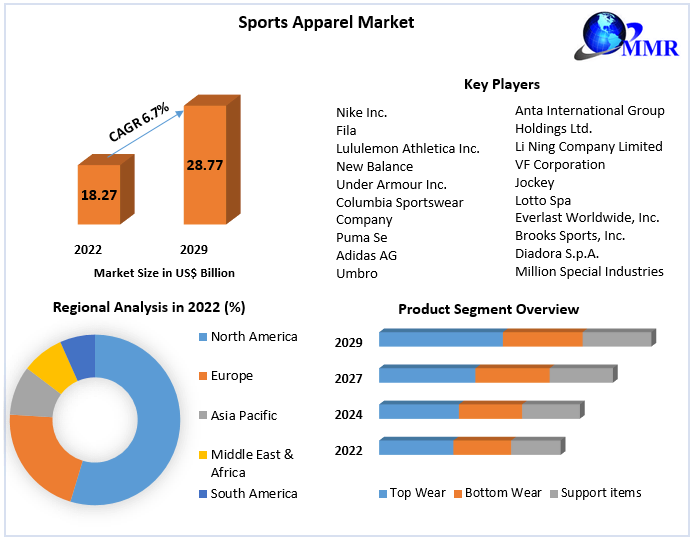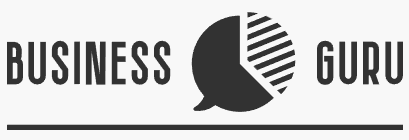The activewear industry is red-hot, expected to grow to over $567 billion globally by 2025. With athleisure becoming a mainstay in closets around the world, more people than ever are seeking fitness apparel that is both functional and stylish.

From boutique yoga pant companies to sport-specific apparel aimed at runners and weightlifters, the possibilities in the activewear space are endless. With some strategic planning around design, manufacturing, and marketing, anyone can turn their passion for fitness into a thriving business.
This guide will walk you through how to start a fitness clothing line. Topics include market research, competitive analysis, obtaining business insurance, applying for an EIN, forming a legal business entity, and more.
1. Conduct Fitness Clothing Line Market Research
Market research is essential to starting a fitness clothing business. It offers insight into trends in fitness wear, the target market for your gym apparel line, local competitors, and more.

Some details you’ll learn through market research for your own fitness clothing line include:
- North America currently leads activewear sales, holding almost half the global market share at $135 billion.
- The primary target demographics within the activewear space include Millennials and Gen Z.
- Gen Z is driving a shift toward athleisure, sustainable fabrics, and innovative retail in fitness clothing.
- Capturing these young, active demographics early on can establish brand loyalty across generations.
- Women’s activewear currently dominates the market, holding almost 75% share compared to roughly 25% for men’s apparel.
- Sports bras, yoga pants, and tank tops reign supreme among female consumers. Consider also that socks are an integral part of every athlete’s clothing collection and they are in constant demand.
- While the fitness clothing space faces competition from athletic giants like Nike and Lululemon, small and midsize brands can differentiate by specializing.
- Targeting specific sports and activities such as golf, tennis, dancing, yoga, running, or boxing allows startups to cater their product offering directly to that consumer lifestyle.
- Sustainability continues gaining importance, with 66% of customers willing to pay more for sustainable activewear.
- New brands have an opportunity to embed eco-friendly practices into their foundation.
The soaring success of athleisure wear and increasing health awareness provide an optimal landscape to launch a disruptive fitness apparel brand. Capitalizing on unmet consumer needs across generations, genders, and geographies offers ample pathways to carve out a niche in this $500 billion industry.
2. Analyze the Competition
Understanding the competitive landscape is crucial for new fitness apparel brands aiming to cut into the activewear market. With industry mammoths like Nike and growing athleisure companies like Outdoor Voices, assessing the playing field helps position your differentiated value.

Some ways to learn about competitors to your successful fitness clothing line include:
- When evaluating brick-and-mortar competition, locate fitness clothing stores in your geographic area to analyze in person.
- Study their branding, price points, product selection, and in-store experiences.
- Track foot traffic and talk to customers about preferences.
- Monitor how specialty boutiques compare to athleisure sections in department stores like Nordstrom or DICK’s Sporting Goods.
- Evaluating eCommerce competitors is also vital even for physical storefronts.
- Sign up for competitor email lists to learn promotional strategies.
- Study social media and user-generated content on sites like Instagram to reveal buyer behavior patterns.
Regular competitor analysis illuminates what drives customer choices today. Tracking shifts over time then helps forecast where white space opportunities may emerge for new specialty fitness clothing brands to activate demand. Pitching perfectly to evolving consumer needs builds loyalty and ensures long-term viability.
3. Costs to Start a Fitness Clothing Line Business
When starting a fitness apparel brand, entrepreneurs must budget for a variety of initial expenses to get their business off the ground. From product development to warehouse space, building the foundations for an activewear company requires a sizable upfront investment.
Start-up Costs
- One of the first start-up costs is designing the actual clothing concepts and creating product samples, which can range from $5,000-$15,000 including pattern making and manufacturing.
- Trademarking a business name and establishing corporate identity elements like a logo often requires around $1,000 when working with professional graphic design freelancers.
- If selling products online first, building a functional e-commerce website with integrated payment processing capability averages $3,000-$7,000.
- Purchasing barcode scanners, label makers, shipping station elements, and basic equipment for packaging orders usually totals another $2,000 in the beginning.
- Warehouse space also needs securing early on to store inventory even when operating predominantly online, costing roughly $2,500 per month for around 500-1,500 square feet.
- Further down the line when expanding into physical retail stores, showroom spaces in shopping centers average $20-$40 per square foot monthly for longer lease terms around 5+ years.
- Architectural planning, layout design services, and building out complete store interiors then land around $100,000 per location. Staffing sales associate roles in stores results in added personnel costs as well.
Ongoing Costs
- Producing wider style assortments demands more fabric, trim materials, labels, packaging, and samples which can tally $50,000 annually depending on volumes and textile costs.
- Digital advertising across social platforms like Instagram and influencer collaborations averages another $40,000 per year, sometimes more to launch impactful campaigns.
- Monthly subscriptions to design software, inventory tracking systems, order management tools, accounting software, and other web services benefiting workflow collectively amount to around $5,000 per year.
Launching a specialty activewear line necessitates around $100,000 in start-up funding along with roughly $100,000 in ongoing annual investments.
4. Form a Legal Business Entity
When starting a fitness clothing brand, properly structuring the legal business entity protects founders while enabling growth. The four main options—sole proprietorship, partnership, corporation, or limited liability company (LLC)—each impact taxation, personal liability, raising capital, and everyday administrative management differently.
Sole Proprietorship
A sole proprietorship constitutes the simplest framework with no distinction between individual and business from a legal perspective. This means owners experience unlimited personal liability for company debts or lawsuits. While easy to form at the outset, it severely lacks protection.
Partnership
Partnerships are a good option for family businesses. They allow multiple owners to pool resources and share responsibility, but still expose assets like houses or cars in the event claims arise against the business.
Corporation
Corporations limit liability but face double taxation on profits and have extensive record-keeping rules. Corporations are best left to large companies with the money and manpower to carry the cost and extensive registration process.
Limited Liability Company (LLC)
Establishing the company as an LLC from launch combines pass-through taxation benefits with personal asset protection for founders. LLC owners pay no income tax on earnings—profits/losses flow through to members’ returns. This avoids double taxes. The LLC structure also shields member possessions like houses if business creditors file claims, preventing full financial exposure.
5. Register Your Business For Taxes
Even as a new LLC, fitness apparel companies need both a federal Employer Identification Number (EIN) and a state sales tax permit to operate legally. The EIN serves as a unique tax ID tied specifically to the business instead of using a founder’s social security number. Sales tax permits enable charging shoppers local sales tax rates on transactions.
Applying for an EIN is free directly through the Internal Revenue Service and takes 5-10 minutes via this link. The online questionnaire asks basic information about the LLC such as name, address, and ownership structure. Providing an SSN isn’t required.
Acquiring a sales tax permit occurs through state government portals, with rates varying by location. For example in California, the BOE-400-SPA form is required along with a $35 fee when expected annual revenue exceeds $100,000.
Keeping the EIN and sales tax ID current with state and federal agencies as the fitness clothing LLC grows ensures everything remains accounted for properly on tax returns. Both numbers can sync directly into e-commerce platforms and accounting software as well for tracking transactions.
6. Setup Your Accounting
Maintaining organized financial records remains imperative for new fitness clothing lines to control costs, properly file taxes, and ultimately scale. Implementing the right accounting software, working with an experienced accountant, and separating personal and business finances from the start helps streamline operations.
Accounting Software
Utilizing small business accounting platforms like QuickBooks provides an accessible way for fitness apparel companies to automate tasks like tracking income and expenses, generating invoices, running payroll, and reconciling bank/credit card statements. Packages start around $30/month for core functionalities like unlimited invoicing and expense tracking.
Hire an Accountant
Pairing DIY software with professional accounting guidance maximizes control. Hiring an accountant on retainer for consultation averages $150-$200 monthly, with additional year-end filings costing around $700. They handle business license renewals, sales tax calculations, annual financial reports, and tax preparation.
Open a Business Bank Account
Separating business and personal finances also remains key from a reporting perspective. Opening dedicated small business checking/savings accounts and credit cards simplifies categorizing transactions later. It also builds legitimacy with future potential investors to showcase reliable financials.
Apply for a Business Credit Card
Applying for a small business credit card requires the company EIN and estimated annual revenue but offers higher initial limits than personal cards, usually around $10,000 to start. Issuers like Capital One and Chase Ink Business Cards deliver optimal rewards on common purchases like manufacturing supplies and digital advertising.
7. Obtain Licenses and Permits
Beyond formally registering as a legal business entity, fitness apparel startups must acquire certain operational licenses and permit to stay compliant. Find federal license information through the U.S. Small Business Administration. The SBA also offers a local search tool for state and city requirements.
At the core, specialty clothing manufacturers must obtain a domestic business license like an LLC or incorporation. This forms the company’s legal foundation for signing contracts, securing credit, and separating personal liability. However additional documentation further enables day-to-day functionality.
For example, a vendor’s permit from the state allows bulk purchasing of fabrics, labels, and materials tax-free to then produce finished garments for sale in-state. These cost between $50-$300 depending on location. Applying requires submitting a state resale certificate with the LLC’s EIN which typically processes within a few weeks.
If producing apparel out-of-state, businesses should also acquire an applicable resale certificate from that region to ship orders tax-free directly to consumers. This prevents unnecessary double taxation but requires meeting annual thresholds like total revenue or volume of items being sold into that area. Exemption requirements vary by state.
Labels and hangtag requirements likewise must comply with Federal Trade Commission rules regarding fiber content, country of origin, fire/flammability warranties, and care instructions. Third-party testing labs can review and certify product compositions where needed.
For businesses planning retail space alongside e-commerce, local municipalities often stipulate additional licenses needed. Zoning permits dictate acceptable commercial activity by geographic area while occupancy certificates confirm buildings meet fire, construction, and Americans with Disabilities Act standards for hosting the public.
8. Get Business Insurance
Acquiring adequate business insurance coverage shields fitness clothing startups from potential financial ruin if unexpected catastrophes strike. Policies cover costs related to property damage, inventory loss, liability claims, and more that could otherwise bankrupt brands.
For example, a fire could destroy a warehouse full of new apparel stock. Flooding might cause thousands in irreplaceable damages to retail stores. Shoppers could file injury lawsuits after alleged accidents onsite.
Without protections, the LLC’s members must pay all repairs, replacements, and legal expenses personally. This could amount to hundreds of thousands owed by individual founders. However, tailored insurance policies shift this risk.
Common starter policies like Business Owner’s Policies (BOPs) bundle property coverage, liability, loss of income, and commercial auto under one convenient package. Rates vary based on location, industry risk, revenue size, and other factors but average $50 monthly for around $500,000 in potential payouts.
The application process begins by contacting independent insurance agents or providers like The Hartford and supplying details about operations, sales, payroll expenses, and claims history. In-person risk assessments also inform quotes. Payments are processed monthly or annually once bound.
9. Create an Office Space
As fitness clothing lines scale production and hire staff, dedicated office space often becomes necessary for daily operations centralized outside the home. While remote work remains popular post-pandemic, having a physical headquarters proves useful over time.
Coworking Office
Coworking spaces like WeWork offer convenient short-term leases for small firms to operate. Tiered monthly memberships start around $300 and provide varying amounts of access to shared workstations, private offices, conference rooms, office equipment, parking, WiFi, kitchens, and amenity spaces for events or meetings. No long-term lease requirement allows for flexible scaling.
Retail Office
For fitness brands opening retail stores, using back office space attaches the headquarters intrinsically to customer-facing operations for seamless coordination. However real estate, construction buildouts, and dedicated inventory warehouse needs drive location costs higher between $3,000-$5,000 monthly. Maximum space capacity also remains finite regardless of future hiring.
Commercial Office
Signing a 5-year lease within a commercial office building provides the most customization for constructing functional headquarters. Typical base rents average $20-$25 per square foot in suburban areas beyond major cities, translating to around $2,000 monthly for 100 sq ft spaces.
10. Source Your Equipment
Launching a specialty activewear brand requires key textile equipment for sampling fabrications, creating patterns, and sewing first batches of apparel in-house before contracting mass production. Sourcing these foundational tools both affordably and locally enables new designers to perfect early collections.
Buy New
Purchasing equipment new allows for custom orders tailored to output needs. Industrial sewing machines start around $2,000 from brands like Juki while multi-head embroidery machines average $7,000-$10,000. Small cutters and fabric spreaders cost $1,500. Investing $15,000 upfront supplies production essentials.
Buy Used
Seeking out discounted second-hand equipment from prior apparel companies proves more budget-friendly. Facebook Marketplace and Craigslist routinely list locally used inventory; broader auction platforms like eBay and Shop goodwill source globally. Smaller startup brands often upgrade machinery quickly, selling functional tools 50-75% below retail.
Rent
Renting production equipment allows for maximizing capital for other branding and product expenses at launch rather than machinery ownership. Online marketplaces like FloTools and UK-based Fat Llama enable short-term rentals from $30/day up to longer 6-12 month leases costing $200/month per unit.
Lease
Leasing acquires necessary textile equipment without major upfront purchases, spreading payments over 3-5 years instead. This preserves working capital for order materials and marketing initiatives upfront. However total spending increases 20-30% overall versus buying outright.
11. Establish Your Brand Assets
Strategically developing a cohesive brand identity helps emerging fitness apparel companies craft market awareness and recognition within the lucrative activewear segment. Beyond designing compelling performance clothing, branding provides visual packaging tying collections to lifestyle messaging.
Get a Business Phone Number
Acquiring a unique business phone line via platforms like RingCentral grants startups a professional presence when contacting suppliers, and retailers, or promoting customer service support. Dedicated numbers with custom greetings project credibility, especially when still operating from a home office early on.
Design a Logo
Commissioning a logo and coordinated visual assets is equally as vital for affiliation. A tailored emblem iconically represents new brands when applied to hangtags, packaging, storefront signage, and digital profiles. Affordable DIY sites like Looka offer kits with fonts, colors, and graphical mark templates paired with patterned backgrounds.
Print Business Cards
Bringing logos full circle, ordering business cards through convenient online print shops like Vistaprint makes informing industry contacts simple. Professionally presenting founders’ names, titles, phone numbers, emails, and social handles when meeting one-on-one or at trade shows accelerates opportunities.
Obtain a Domain Name
Securing matching domain names allows for centralizing products and brand narratives online. Services like Namecheap enable quickly checking domain availability during business registration to claim ideal .com extensions, secured typically for less than $15 yearly.
Design a Website
Building out full e-commerce sites further spotlights fitness apparel collections and missions. Leveraging user-friendly website builders like Wix grants entrepreneurs DIY control. The less web-savvy can hire freelance developers affordably from marketplaces like Fiverr starting at around $500.
12. Join Associations and Groups
Tapping into local networks and national industry groups allows fledgling fitness clothing companies to learn best practices directly from established peers. Joining relevant meetups, trade organizations and online communities builds camaraderie while unlocking actionable advice.
Local Associations
Major fashion hubs like Los Angeles and New York and specialized associations like the California Fashion Association cater to applicant apparel brands through mixers, workshops, and directory listings. Annual dues of around $500 access seasonal networking events and industry intel.
Local Meetups
Attending generalized small business meetups facilitated via platforms like Meetup also allows founders to exchange local intel across sectors. Casual coffees and open discussions generate referrals to trusted photographers, branding agencies, prospective media contacts, and more.
Facebook Groups
Participating in dedicated Facebook Groups bridges founders digitally with existing fitness apparel labels nationally. For example, Fitness Clothes and Equipment- Buy, Sell, Swap and Small USA Business Owners’ Network offer support to newcomers. Threads commonly detail manufacturing hurdles, core customer psychographics, trade show advice, and halo collaborations with influencers.
13. How to Market a Fitness Clothing Line Business
Implementing multifaceted marketing and customer retention strategies enables emerging fitness clothing brands to systematically promote products, build awareness, and drive recurring sales. While digital platforms provide efficient reach, word-of-mouth referrals from satisfied shoppers ultimately cement organic growth.
Personal Networking
As most startups that sell workout clothes rely heavily on core networks early on, customers who share collections with friends prove invaluable. Gifting 10-20% off coupons or free leggings to patrons who tag new customers on your athletic clothing line social media feed both rewards loyalty while expanding exposure virally.
Digital Marketing
- Google/Facebook Ads: PPC campaigns target local demographics most likely to convert based on interest and search data. Expect around $1-2 CPA optimizing to scale budgets upwards of $10K+ monthly
- Instagram Sponsorships: Micro-influencer collaborations with niche fitness coaches, trainers, and athletes boost reputation. Typical packages around $500-1,000 per post
- Email Marketing: Segmented newsletters, abandoned cart reminders, and birthday discounts reengage subscribers directly for repeat sales about 25-50% of the time
- YouTube Hauls: Sponsor product unboxings by channels focused on athleisure reviews. Ad inventory prices average $0.010 – $0.030 per view depending on viewership size
Traditional Marketing
- Direct Mail: Targeted postcard drops to local athleisure boutiques, gyms, and studios establish connections within geographic communities to eventually wholesale product
- Flyers: Distributing marketing materials at regional conferences, trade shows and pop-up events raises interest during times when fashion buyers are actively looking
- Radio: Booking 30-60 sec FM radio ad spots around workout programs ultimately targets drive-time commuters. However, response attribution proves difficult long-term
Blending both targeted digital strategies paves a scalable growth path for an emerging fitness apparel line.
14. Focus on the Customer
Delivering exceptional customer service fundamentally fuels growth for specialty fitness clothing brands through building consumer loyalty and word-of-mouth referrals. How a company’s team engages before, during, and after transactions directly informs the shopping experience.
For example, fitness enthusiasts first evaluating new legging brands heavily factor in social media responsiveness and website FAQ depth when comparing options online. Promptly replying to questions about compression levels or sizing guidance earns trust in quality and customer care from the outset.
Fulfilling orders accurately and quickly then meeting baseline expectations once purchased. However, brands going beyond by including handwritten thank you notes or small gifts with shipments make buyers feel genuinely appreciated by a fitness apparel business.
Post-purchase care similarly prevents issues from escalating negatively. Self-service tools like size exchange portals solve problems independently while fast responses to one-off concerns maintain positive perceptions. Checking in a few weeks later about wearing experiences shows the relationship extends past the sale of workout clothes.
Fitness shoppers greatly value brand integrity, product performance, and self-expression through activewear. But feeling individually valued through thoughtful customer service touches ignites the lasting affinity and sense of community that inspires recommending emerging brands to fellow athletes.
